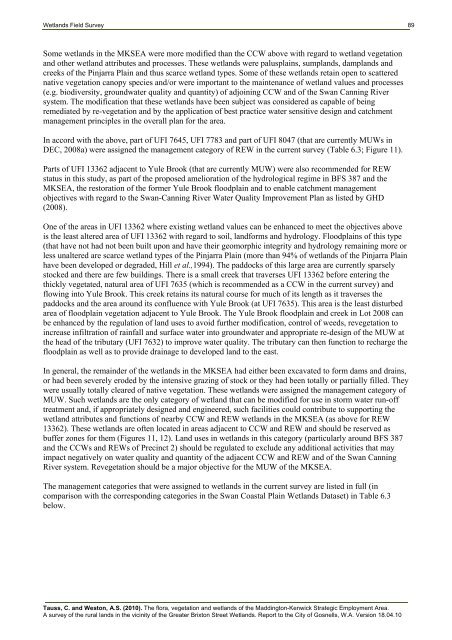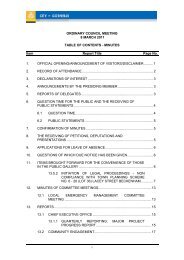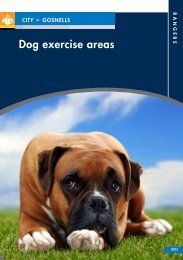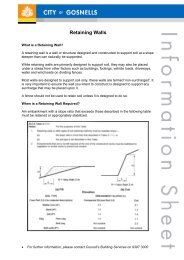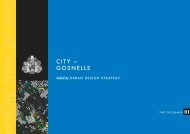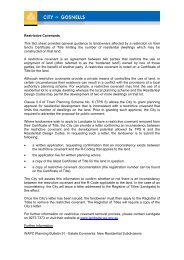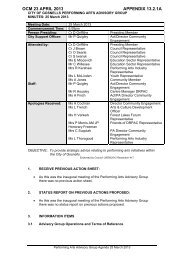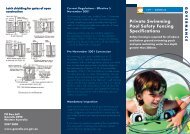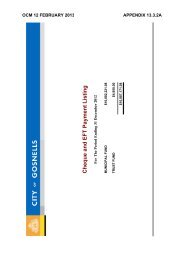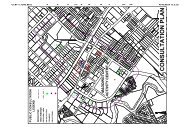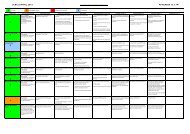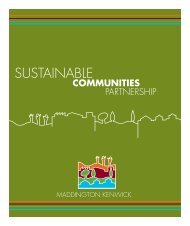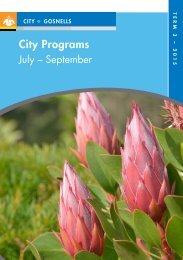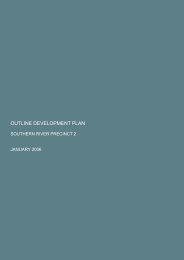Summary - City of Gosnells
Summary - City of Gosnells
Summary - City of Gosnells
You also want an ePaper? Increase the reach of your titles
YUMPU automatically turns print PDFs into web optimized ePapers that Google loves.
Wetlands Field Survey 89Some wetlands in the MKSEA were more modified than the CCW above with regard to wetland vegetationand other wetland attributes and processes. These wetlands were palusplains, sumplands, damplands andcreeks <strong>of</strong> the Pinjarra Plain and thus scarce wetland types. Some <strong>of</strong> these wetlands retain open to scatterednative vegetation canopy species and/or were important to the maintenance <strong>of</strong> wetland values and processes(e.g. biodiversity, groundwater quality and quantity) <strong>of</strong> adjoining CCW and <strong>of</strong> the Swan Canning Riversystem. The modification that these wetlands have been subject was considered as capable <strong>of</strong> beingremediated by re-vegetation and by the application <strong>of</strong> best practice water sensitive design and catchmentmanagement principles in the overall plan for the area.In accord with the above, part <strong>of</strong> UFI 7645, UFI 7783 and part <strong>of</strong> UFI 8047 (that are currently MUWs inDEC, 2008a) were assigned the management category <strong>of</strong> REW in the current survey (Table 6.3; Figure 11).Parts <strong>of</strong> UFI 13362 adjacent to Yule Brook (that are currently MUW) were also recommended for REWstatus in this study, as part <strong>of</strong> the proposed amelioration <strong>of</strong> the hydrological regime in BFS 387 and theMKSEA, the restoration <strong>of</strong> the former Yule Brook floodplain and to enable catchment managementobjectives with regard to the Swan-Canning River Water Quality Improvement Plan as listed by GHD(2008).One <strong>of</strong> the areas in UFI 13362 where existing wetland values can be enhanced to meet the objectives aboveis the least altered area <strong>of</strong> UFI 13362 with regard to soil, landforms and hydrology. Floodplains <strong>of</strong> this type(that have not had not been built upon and have their geomorphic integrity and hydrology remaining more orless unaltered are scarce wetland types <strong>of</strong> the Pinjarra Plain (more than 94% <strong>of</strong> wetlands <strong>of</strong> the Pinjarra Plainhave been developed or degraded, Hill et al.,1994). The paddocks <strong>of</strong> this large area are currently sparselystocked and there are few buildings. There is a small creek that traverses UFI 13362 before entering thethickly vegetated, natural area <strong>of</strong> UFI 7635 (which is recommended as a CCW in the current survey) andflowing into Yule Brook. This creek retains its natural course for much <strong>of</strong> its length as it traverses thepaddocks and the area around its confluence with Yule Brook (at UFI 7635). This area is the least disturbedarea <strong>of</strong> floodplain vegetation adjacent to Yule Brook. The Yule Brook floodplain and creek in Lot 2008 canbe enhanced by the regulation <strong>of</strong> land uses to avoid further modification, control <strong>of</strong> weeds, revegetation toincrease infiltration <strong>of</strong> rainfall and surface water into groundwater and appropriate re-design <strong>of</strong> the MUW atthe head <strong>of</strong> the tributary (UFI 7632) to improve water quality. The tributary can then function to recharge thefloodplain as well as to provide drainage to developed land to the east.In general, the remainder <strong>of</strong> the wetlands in the MKSEA had either been excavated to form dams and drains,or had been severely eroded by the intensive grazing <strong>of</strong> stock or they had been totally or partially filled. Theywere usually totally cleared <strong>of</strong> native vegetation. These wetlands were assigned the management category <strong>of</strong>MUW. Such wetlands are the only category <strong>of</strong> wetland that can be modified for use in storm water run-<strong>of</strong>ftreatment and, if appropriately designed and engineered, such facilities could contribute to supporting thewetland attributes and functions <strong>of</strong> nearby CCW and REW wetlands in the MKSEA (as above for REW13362). These wetlands are <strong>of</strong>ten located in areas adjacent to CCW and REW and should be reserved asbuffer zones for them (Figures 11, 12). Land uses in wetlands in this category (particularly around BFS 387and the CCWs and REWs <strong>of</strong> Precinct 2) should be regulated to exclude any additional activities that mayimpact negatively on water quality and quantity <strong>of</strong> the adjacent CCW and REW and <strong>of</strong> the Swan CanningRiver system. Revegetation should be a major objective for the MUW <strong>of</strong> the MKSEA.The management categories that were assigned to wetlands in the current survey are listed in full (incomparison with the corresponding categories in the Swan Coastal Plain Wetlands Dataset) in Table 6.3below.Tauss, C. and Weston, A.S. (2010). The flora, vegetation and wetlands <strong>of</strong> the Maddington-Kenwick Strategic Employment Area.A survey <strong>of</strong> the rural lands in the vicinity <strong>of</strong> the Greater Brixton Street Wetlands. Report to the <strong>City</strong> <strong>of</strong> <strong>Gosnells</strong>, W.A. Version 18.04.10


